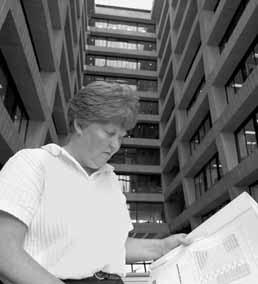|
Engineering the Workplace
by Mike Perricone
 "Physics on the prairie" calls up images of sweeping natural vistas, of high skies, grasslands and wildlife.
"Physics on the prairie" calls up images of sweeping natural vistas, of high skies, grasslands and wildlife.
Physicists on the prairie, however, tend to do their best work indoors, with plenty of heat, water and electrical outlets. It all starts with a building, and buildings are just the start of the responsibilities for Fermilab's Facilities Engineering Services Section.
If the infrastructure--the pipes, the plumbing, the power cables, the heating and cooling, the roads and buildings, the intricate pond network--on the frontier of high-energy physics functions smoothly in Run II, it will mean FESS has done its job; if there's a glitch anywhere, FESS will be on the job. Immediately, if not sooner.
"If a call goes out because of a problem at 2 a.m., our people are right there. No questions asked," says David Nevin, head of the nearly 150 engineers, architects, technicians, carpenters, janitors and support people staffing FESS.
FESS sees its mission as no less than the safeguarding of Fermilab science.
 "It is absolutely critical that the experiments remain `up,' that they're able to collect good information and capture good interactions," Nevin says. "Any time an experiment cannot perform that task, billions of pieces of valuable information are being lost. That's it--they're gone.
"It is absolutely critical that the experiments remain `up,' that they're able to collect good information and capture good interactions," Nevin says. "Any time an experiment cannot perform that task, billions of pieces of valuable information are being lost. That's it--they're gone.
"Our job, as far as any function of infrastructure, is to ensure that losses of information are at an absolute minimum. We know we can't achieve zero losses, but our mission is to drive that number as close to zero as possible."
While the detectors and the accelerator complex have been virtually reinvented for Run II, much of the laboratory's infrastructure has served for three decades and is reaching its design limit. At that stage, anything can happen, and often does. Some of the major FESS projects to make aging infrastructure serve frontier physics:
Wilson Hall Safety Improvements Project: This three-year, $18-million revamping of the lab's signature building was occasioned in part by a chunk of loose concrete that broke one of the cafeteria windows in 1993. Under Elaine McCluskey's direction, the effort has replaced improperly-installed joints in the crossovers that tie Wilson Hall's towers together; installed new skylights, and new safety glass in the north and south faces; installed new plumbing. The final phase, reworking the building's front entrance, will be completed this summer.
Utilities Incentive Program: A Federal program allows commercial utilities--in this case, ComEd and NICOR--to provide the lab with new facilities and receive payment through resulting savings in energy costs. The first UIP project, in 1999, provided a new chiller for the Central Utility Building. ComEd invested $3.5 million, and the lab's current annual saving in energy cost is $900,000. By the end of FY04, Fermilab will be finished repaying ComEd out of those annual savings. In FY00 and FY01, UIP contracts totaling $52 million will save about $6.5 million in annual energy costs.
New feeder cables: Fermilab has 15 miles of power cable above ground--and another 100 miles of power cable below ground, taking in 345,000 watts of electricity from ComEd and feeding it around the site. Nevin has a chart on his wall noting feeder cable failures with red dots; he says "it started to look like a bad case of measles." In 2000, there were 23 feeder cable failures--and the lab still hadn't begun a full-out experimental run. With UIP help, FESS has begun replacing old cables to instill a new level of reliability instead of just trying to keep up with failures. The result: just two feeder cable failures in 2001 by mid-April with Run II underway.
New power substation: Part of the Main Injector Project completed in 1999, the new substation allows splitting the load between two main feeders from ComEd. The flexibility adds significant reliability; a failure in a main feeder now affects only the facilities fed by that substation, and power can be "backfed" from the other substation.
FESS does much of its work behind the scenes. Some equipment had to be serviced before Run II could start, because it wouldn't be accessible once the accelerators were running. The run couldn't begin without all power and water utilities fully operating. The ponds, circulating the cooling water for magnets and electronic components around the lab, must be maintained at the proper levels, temperatures and evaporation rates.
FESS makes it all work. Turn on the lights, set the thermostat, and have some fresh coffee. Physics on the prairie feels just like home.
|

 "Physics on the prairie" calls up images of sweeping natural vistas, of high skies, grasslands and wildlife.
"Physics on the prairie" calls up images of sweeping natural vistas, of high skies, grasslands and wildlife.
 "It is absolutely critical that the experiments remain `up,' that they're able to collect good information and capture good interactions," Nevin says. "Any time an experiment cannot perform that task, billions of pieces of valuable information are being lost. That's it--they're gone.
"It is absolutely critical that the experiments remain `up,' that they're able to collect good information and capture good interactions," Nevin says. "Any time an experiment cannot perform that task, billions of pieces of valuable information are being lost. That's it--they're gone.